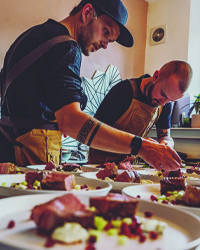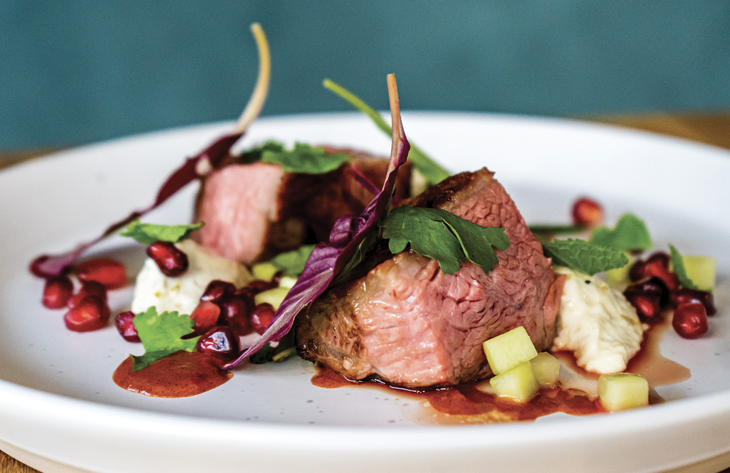
Nathan Rackham is the chef/owner of Journal Dining, a new business in East Anglia that puts ethics and staff welfare at top of its list. From his Norfolk roots to his French Michelin background, Nathan puts good relationships and happy staff first; when all combined, it enables him to take his guests on a journey through the flavours of his life.
My love of food originated from a young age. I would always cook with my mother as soon as I could reach the worktop from my white stool, helping bake cakes and bread and make fresh pasta. As a child, we often travelled as my father worked away from home. This meant that we ate out frequently, often in good restaurants where we experienced high standards of food and service. Growing up around a family who forever works hard but always plays hard, hospitality fell into its own.
I trained as a chef in a restaurant called Le Pont De L’Ouysse in Lacave in the Dordogne Valley, France. A classic French Michelin-starred restaurant and hotel, it has been run by the Chambon family for five generations.
On returning to England, I went to another Michelin restaurant, this time Paris House in Woburn where I learned more modern scientific cooking techniques. Development of dishes was vital with a team mentality of being a singular unit at all times – definitely not your usual shouty volatile kitchen that the industry is famous for. While there, I learned great management skills as well as cooking techniques.
I returned home to Norfolk and worked for Daniel Smith at The Wildebeest in Stoke Holy Cross, developing that with the team for the first two years of Dan’s ownership. We gained attention from Michelin as well as AA rosette awards. While working there, I made the finals of Norfolk Chef of the Year.

From there, it was opening the award-winning Farmyard Restaurant with Andrew Jones for a short stint before moving to the highly awarded Benedicts with Richard Bainbridge.
I went to Suffolk shortly after, where I worked for Wilderness Reserve as a private chef for a collection of exclusive use luxury holiday cottages set on an 8,000-acre estate. We would often deal with high profile celebrity guests, corporate hospitality, and exclusive weddings and parties. The dining experiences offered included a unique taster menu cooked over open fires in the stunning woodlands on the estate.
I did more private cheffing in luxury chalets in the Alps, where I was able to combine my love of food with a passion of snowboarding.
After four years of planning, I finally opened Journal Dining. The push to begin came about when I noticed all my friends in the industry were leaving to do other jobs outside of hospitality; years of being underpaid and mistreated had finally reared its head. I decided to do something about it and opened Journal Dining and take it as far as I can while still maintaining the principles of being ethical and looking after the staff and producers as well as the customers at all times.

Although we are in the early stages of our journey, and currently not large enough for full-time staff, staff welfare is always a priority. We make sure we pay as much as we can, always a large percentage more than the national living wage. Most importantly, we try to address the issue of mental health within the industry. We open avenues for people to feel comfortable and happy, and we have an open policy whereby staff can talk if they need to.
As for the concept of Journal Dining, the concept came about because every chef carries a journal of recipes, notes, experiences and so much more with them, very much like chapters. Over time, you build a collection of these books in which you look back and develop new ideas from your past. When diners come to enjoy my food, they get to enjoy a journey rather than just a meal.
As for the food itself, it is fine dining without all the stiffness. We use the finest techniques to emphasise the ingredient rather than mess with it. We source the finest local seasonal ingredients where possible.
We currently use suppliers such as Charlie’s Leaves. I spent a lot of time with Charlie at his farm, looking at how he develops his products and what produce he has coming up. The September menu, for example, will showcase his fabulous heritage tomatoes – you can’t beat them. They are juicy, full of flavour, and only picked when they are ready. We also use Clarkes Butchers, who rear high-quality livestock. Fen Farm Dairy is one of our favourites with exceptional cheeses and raw dairy products. They also try to be as eco-friendly as possible, which fits in with our ethics.
I like to support smaller scale independent suppliers where possible. My aim is to be helpful to everyone, with arranged visits to small scale farms, butchers, orchards, raw milk producers, and so on to do video edits and showcase them on social media. I don’t want Journal Dining just to be about us – I want it to be about ethical business and supporting others. That way, everybody wins.
Something that is important are the global climate problems we are facing, and Journal Dining looks at how we, as an economy, consume food. Our aim is to bring more responsible dining to the table, either through the sourcing of the ingredient, using less of a product that is bad for the environment or health, or just as simple as being as waste free as possible.

You can find Journal Dining three ways. The first is as a pop-up supper club, where we go into other venues and do a takeover evening. We hold at least two a month, generally around Norwich, but we are looking further afield. The second way is through private dining in your own home or at the selected venue. Finally, we also cater for larger parties, weddings, and other events.
The menu for the supper clubs is divided into chapters to help take you on your journey through your meal, much the same as reading a book, or notes in a journal. The menu is listed as ingredients to give the diner enough knowledge of what they are eating without telling them how I am going to do it – I do love that surprise element! Dishes such as the carrot and duck dish has just six ingredients – chamomile roast carrot, duck ham, carrot puree, puffed wild rice, toasted almonds, lovage oil, Charlie’s leaves, and a duck jus.
In September, as well as the heritage tomato dish that showcases this amazing fruit, we will also use the first of the season’s apples for a beautiful apple terrine. We have so many amazing varieties in this country, and many don’t get used.
Dining for me has to be much more than just eating a meal. It has to be personal, and it has to be exciting. As chefs, it is our job to throw out the rule book and give the diners the best experience that we can.

Finally, people talk about food heroes a lot. Most have very influential chefs who are usually very well
known. However, for me it is much closer to home. My partner, Taylor, is my food hero. She always makes sure that no matter how hard I am working, or how stressed I am, that I am eating the healthiest meal possible to restore balance.
- E-mail journaldining@gmail.com or follow Journal Dining on social media at @JournalDining (Facebook); @journal_dining (insta)
- Don’t forget to give Nathan’s recipe for tonka bean and red miso caramel millionaires’ shortbread a try!










